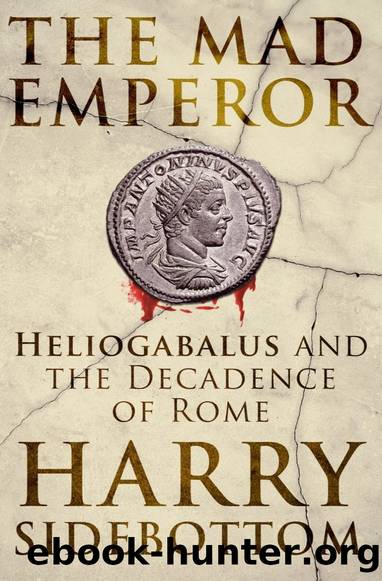The Mad Emperor: Heliogabalus and the Decadence of Rome by Harry Sidebottom

Author:Harry Sidebottom [Sidebottom, Harry]
Language: eng
Format: epub
ISBN: 9780861542543
Google: HZJmEAAAQBAJ
Amazon: 0861542533
Barnesnoble: 0861542533
Goodreads: 60320341
Publisher: Oneworld Publications
Published: 2022-09-07T11:53:03+00:00
Chapter 7: In Rome
AD219â21
I Adventus
Having spent the winter in Nicomedia (AD219â20), Heliogabalus âmade his way into Italy through Thrace, Moesia, and each Pannonia, and he stayed there until the end of his lifeâ. A late third-century document known as the Antonine Itinerary, which set out halting places and became a road map for later Emperors, might have its origins in the journey to the East of Caracalla in AD213. It is possible that Heliogabalus retraced the route of his âfatherâ when heading west. The one certainty is that Maesa ensured that her grandson toured many of the garrisons in the provinces through which they passed. An Emperor needed to show himself to his troops.
Artefacts in two locations might record the visit of the young Emperor. A pair of statues found at Carnuntum, the base of Legio XIV Gemina on the Danube in Pannonia Superior, have been identified as Heliogabalus. Both have been deliberately damaged, and one is very unusual. We will look at them when we discuss his sexuality (chapter 10). Although it might be doubted that the imperial party travelled so far north as Carnuntum â although, as we will see, there was plenty of time â one town through which they definitely went was Aquileia, the gateway to Italy from the East. A relief sculpture has been argued to commemorate the arrival in the town of Heliogabalus and his cousin Alexianus.
Preceded by three attendants, two young males ride in a carriage pulled by donkeys. Behind them four porters carry a litter, on which might be a small shrine containing a conical object, which is about the size of one of the human heads. The young males have short hair, and the one in the foreground wears a toga, and has a chubby face.
The style of the relief points to the third century. The procession may well be religious. Alexianus could have been with Heliogabalus. But then the doubts start to mount up. Nothing in the iconography clearly distinguishes the main figure as an Emperor. One of the attendants carries something over his shoulder, but not necessarily the axe bound by rods of the fasces which were carried in front of an Emperor. Would an Emperor arrive for a ceremony of Adventus in a carriage pulled by donkeys? The two main figures are the same size â in art relative stature often was a sign of status â and in AD219 Alexianus had no official role. Alexianus was five years younger than Heliogabalus, but these boys appear to be the same age. The object in the litter â although vaguely the right shape â is far smaller than any depiction of the black stone of Elagabal, which usually was conveyed in a chariot drawn by four horses. And the relief was not found in Aquileia, but round the gulf at the north of the Adriatic in Trieste. Once again, we must remember the factors nudging art historians to identify every ancient portrait with a famous individual.
Download
This site does not store any files on its server. We only index and link to content provided by other sites. Please contact the content providers to delete copyright contents if any and email us, we'll remove relevant links or contents immediately.
| France | Germany |
| Great Britain | Greece |
| Italy | Rome |
| Russia | Spain & Portugal |
Fanny Burney by Claire Harman(26530)
Empire of the Sikhs by Patwant Singh(22980)
Out of India by Michael Foss(16792)
Leonardo da Vinci by Walter Isaacson(13189)
Small Great Things by Jodi Picoult(7024)
The Six Wives Of Henry VIII (WOMEN IN HISTORY) by Fraser Antonia(5400)
The Wind in My Hair by Masih Alinejad(5034)
A Higher Loyalty: Truth, Lies, and Leadership by James Comey(4851)
The Lonely City by Olivia Laing(4751)
The Crown by Robert Lacey(4731)
Millionaire: The Philanderer, Gambler, and Duelist Who Invented Modern Finance by Janet Gleeson(4386)
The Iron Duke by The Iron Duke(4294)
Papillon (English) by Henri Charrière(4199)
Sticky Fingers by Joe Hagan(4106)
Joan of Arc by Mary Gordon(4022)
Alive: The Story of the Andes Survivors by Piers Paul Read(3970)
Stalin by Stephen Kotkin(3883)
Aleister Crowley: The Biography by Tobias Churton(3589)
Ants Among Elephants by Sujatha Gidla(3417)
